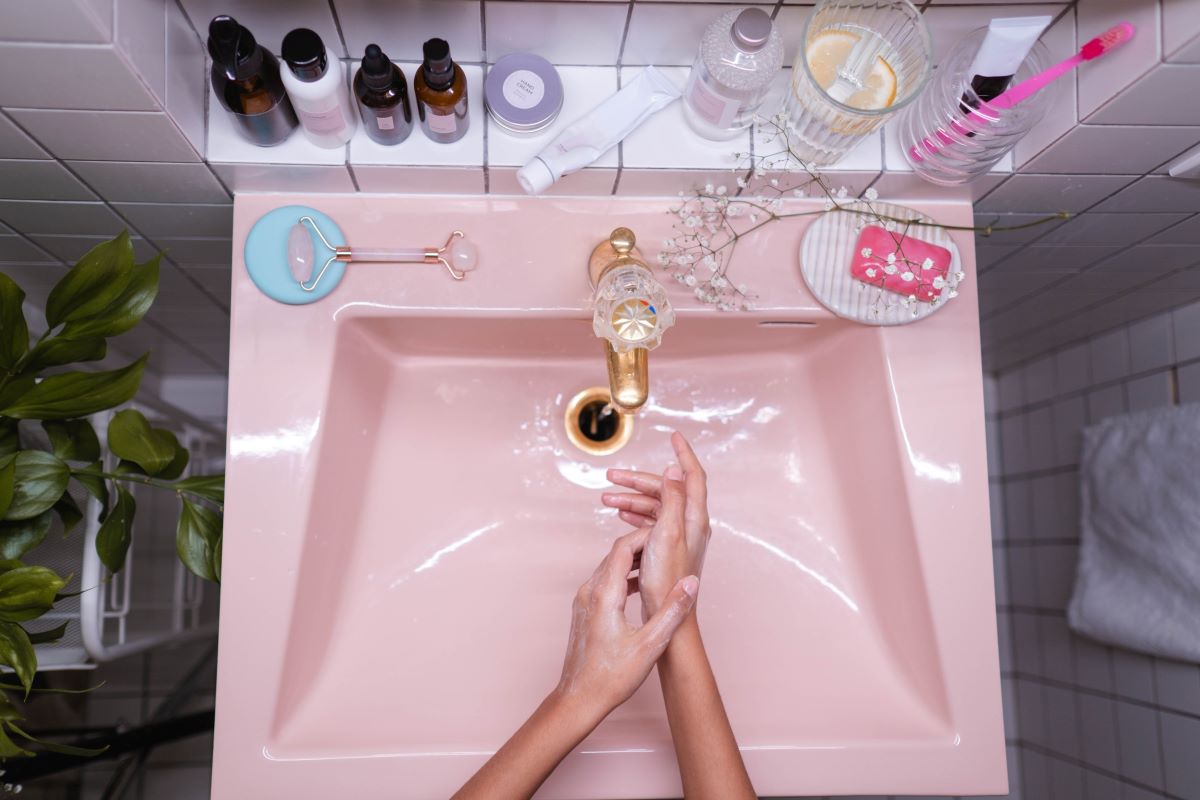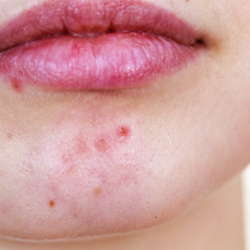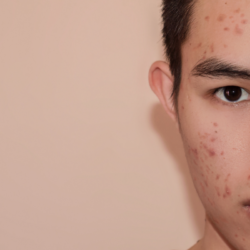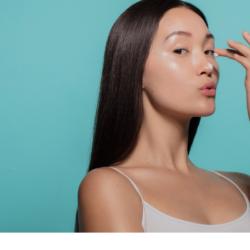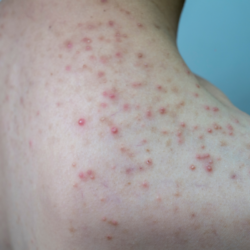When you suffer from acne, you often feel lost when it comes to choosing between all the products available on the market. Drying products, astringent products, exfoliating products, exfoliating masks… It’s hard to find your way around. At Soin & Nature, we’re here to help you create your own skincare routine, 100% tailored to the needs of your skin!
What is acne?
Acne is a very common skin condition. In fact, it’s a disorder of the hair follicles and sebaceous glands. The sebaceous glands secrete sebum to keep the skin hydrated. A real protection against the outside environment. Unfortunately, clogged pores can lead to pimples and cysts.
Causes of acne
Clogged pores, overproduction of sebum, bacteria, hormonal changes, diet and inflammation: these factors can all contribute to the formation of acne. That’s why it’s so important to learn how to pamper your skin on a daily basis. The aim is to create a skincare routine that’s 100% suited to YOUR skin!
When it comes to acne-prone skin, consistency and regularity are essential: you MUST avoid changing products every four mornings. What’s more, it’s best not to use too many active ingredients at the same time, to avoid damaging the skin. In fact, the more the skin is stressed by the use of various products, the more it will tend to secrete sebum in return. Overworked skin is also more prone to inflammation.
The skin
Made up of water, proteins, fatty acids and minerals, the skin is the largest organ in the human body. The epidermis protects the body from microbes and regulates temperature. In addition, the sensations of hot and cold perceived in the skin are felt thanks to the nerves that make it up.
The skin is made up of three layers: the epidermis, the dermis and the hypodermis.
The role of the healthy epidermis
A real protective barrier:
The epidermis is our body’s first line of defence. It is a protective barrier that prevents germs and bacteria from entering our bodies. It plays a crucial role in protecting us from external elements such as wind, rain and, above all, the sun. This barrier is all the more important for acne-prone skin, as any damage can worsen the condition.
Why is the epidermis essential in the fight against acne?
A healthy epidermis means skin that is less susceptible to irritation and inflammation. For acne sufferers, maintaining the integrity of this barrier is essential. This means using suitable products and a skincare routine that respects and reinforces this natural barrier.
Regeneration :
The epidermis’ extraordinary capacity for regeneration is a major asset for acne-prone skin. In fact, our skin renews itself completely every 30 days, constantly producing new skin cells. This regeneration plays a key role in healing acne lesions and reducing post-acne marks.
How can we optimise the regeneration process for acne-prone skin?
To promote effective regeneration, we recommend using products containing retinoids or salicylic acid, which accelerate cell renewal and help to eliminate dead cells, thereby reducing pore clogging and the appearance of new pimples.
Body protection:
Within the epidermis, Langerhans cells play a key role. They are part of the immune system and act like real soldiers in the fight against germs and bacteria. These cells are of vital importance for people with acne-prone skin, as they help to fight infection and reduce inflammation.
What impact do Langerhans cells have on acne?
By controlling the skin’s immune response, Langerhans cells can reduce inflammation and prevent secondary infections of acne lesions. It is therefore essential to maintain a healthy skin immune function, by avoiding aggressive products and adopting a gentle but effective skincare routine.
The best active ingredients for acne-prone skin
A. Salicylic acid
Why is salicylic acid a must for acne?
Salicylic acid is a powerful ally in the fight against acne. As a beta-hydroxy acid (BHA), it works by exfoliating the skin and unclogging pores. This active ingredient is particularly effective in treating blackheads and superficial pimples, thanks to its ability to penetrate pores and dissolve excess sebum and dead skin cells.
B. Retinoids
How do retinoids transform acne-prone skin?
Retinoids, derivatives of vitamin A, are recognised for their effectiveness in treating moderate to severe acne. They encourage cell renewal and help to reduce the formation of blackheads. Retinoids can also improve the appearance of acne scars by accelerating skin regeneration.
C. Benzoyl peroxide
What are the superpowers of benzoyl peroxide against acne?
Benzoyl peroxide is another leading active ingredient in the treatment of acne. As a powerful antibacterial agent, it targets acne-causing bacteria such as Propionibacterium acnes. It also helps to reduce inflammation and can be used in combination with other treatments for greater effectiveness.
D. Azelaic acid
Why is azelaic acid an unsung hero in the treatment of acne?
Azelaic acid stands out for its antibacterial and anti-inflammatory properties. It is particularly effective in treating inflammatory acne and is well tolerated by sensitive skin. What’s more, it helps reduce hyperpigmentation, making it an excellent choice for people with skin prone to post-acne marks.
E. Niacinamide
How can niacinamide transform acne-prone skin?
Niacinamide, or vitamin B3, is a versatile active ingredient for acne-prone skin. Not only does it help to reduce inflammation and hyperpigmentation, it also strengthens the skin barrier and regulates sebum production. It’s ideal for those looking for a gentle yet effective treatment for acne.
Choosing the right products for acne-prone skin
Cleanser :
Cleansing your face morning and night gets rid of the impurities that accumulate on your skin throughout the day. In fact, you should do a “double cleanse”: first with an oil-based product to dissolve make-up and sun protection. Pure plant oils, such as Jojoba or Sweet Almond, are an excellent option. Apply to the face with a damp cotton pad, using small circular movements. Secondly, use an extra-gentle cleanser such as Mustela Stelatopia Cleansing Gel, so as not to dry out the skin.
The serum:
The serum is an important step in your skincare routine. In other words, it boosts the action of all the products you use on your face afterwards. In fact, thanks to its extra-fluid texture, it allows the other active ingredients to penetrate deep into the epidermis. Laroche Posay’s Effaclar serum, SVR’s Sebiaclear anti-imperfections and the B3 ampoule from the same laboratory are great options for acne-prone skin.
Moisturiser:
Moisturising your skin is perhaps the most important step in your routine. The fatty acids present in the skin help maintain moisture. What’s more, they act as a protective barrier between your skin and the outside environment. As a result, if you neglect moisturising, you’re likely to end up with dry, dull and more vulnerable skin. For me, the Cerave range is one of the most interesting. And why is that? Well, because it’s suitable for all skin types. It can be used on the body as well as the face. What’s more, its composition is enriched with ceramides (the skin’s real glue), hyaluronic acid (a moisture booster) and niacinamide (a real anti-inflammatory and repairing concentrate). In short, it’s the trifecta of healthy skin! Of course,other options are available from our online Organic Pharmacy.
Sun protection :
Sun cream is the essential step in maintaining healthy skin. In fact, broad-spectrum sun protection, such as Photoderm AR cream, helps combat redness and inflammation. Many options are available for acne-prone skin, such as Effaclar duo SPF 30 or Laroche Posay’s invisible anti-shine mist.
What is the ideal skincare routine for acne-prone skin?
| Time of day | Step | Action |
|---|---|---|
| A. Morning | 1. Cleansing | Use a gentle cleanser to cleanse the face, favouring non-irritating, non-greasy formulas. |
| 2. Treatment application | Apply an acne-specific treatment, such as a lotion containing salicylic acid or niacinamide. | |
| 3. Moisturising and sun protection | Moisturise with a light, non-comedogenic cream and apply a broad-spectrum sunscreen to protect the skin from UVA and UVB rays. | |
| B. Evening | 1. Deep cleansing | Carry out a more intensive cleansing, possibly using a glycolic or lactic acid-based cleanser for gentle exfoliation. |
| 2. Localised treatment | Apply targeted treatments to pimples or problem areas, such as retinoid or benzoyl peroxide creams. | |
| 3. Moisturising | Use a moisturiser adapted to acne-prone skin to restore balance and support the skin barrier overnight. |
Should I avoid exfoliating when I have acne?
The question of whether to exfoliate acne-prone skin is a complex one. Here are a few key points to consider:
- Risks associated with Mechanical Scrubs: Mechanical scrubs, which use solid particles to exfoliate, can be too aggressive for acne-prone skin. This type of exfoliation can cause irritation, micro-trauma and worsen the condition of the acne. What’s more, there’s a risk that the bacteria will spread to other areas of the face, leading to new eruptions.
- Negative Effects of Excessive Exfoliation: Exfoliating too often or too intensely can remove the skin’s natural oils, leading to excessive dryness and irritation. It can also increase the skin’s sensitivity to other skin care products and encourage acne breakouts.
- Benefits of Gentle Chemical Exfoliation: For acne-prone skin, chemical exfoliants such as salicylic acid, glycolic acid or enzymes are recommended. These exfoliants work gently to dissolve and eliminate dead skin cells, encouraging cell renewal without damaging the skin. Salicylic acid, for example, is known for its ability to penetrate deep into pores and unclog them.
- Gentle cleansing as natural exfoliation: Regular but gentle cleansing, morning and night, can be enough to exfoliate the skin naturally. By removing impurities and excess sebum, this type of cleansing helps to maintain healthy skin without the need for aggressive mechanical exfoliation.
Read more:
- Lasers Med Sci. 2024 Mar 19;39(1):92. doi: 10.1007/s10103-024-04039-6. Recent advances in the treatment of acne using radiofrequency techniques
- Drug Ther Bull. 2024 Jan; 62(1). Managing acne vulgaris: an update
- J Dermatolog Treat. 2024 Dec; The primary role of sebum in the pathophysiology of acne vulgaris and its therapeutic relevance in acne management
- J Drugs Dermatol . 2014 Aug;13(8):s89-94. The importance of photoprotection and moisturization in treating acne vulgaris
- Sci Rep. 2024 Feb 22; Prevalence of acne and its impact on quality of life and practices regarding self-treatment among medical students

